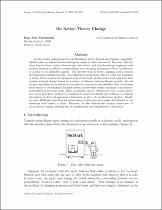JavaScript is disabled for your browser. Some features of this site may not work without it.
- ResearchSpace
- →
- Research Publications/Outputs
- →
- Journal Articles
- →
- View Item
| dc.contributor.author |
Varzinczak, IJ

|
|
| dc.date.accessioned | 2010-11-15T12:41:19Z | |
| dc.date.available | 2010-11-15T12:41:19Z | |
| dc.date.issued | 2010-02 | |
| dc.identifier.citation | Varzinczak, IJ. 2010. On action theory change. Journal of Artificial Intelligence Research, Vol. 37, pp 189-246 | en |
| dc.identifier.issn | 1076-9757 | |
| dc.identifier.uri | http://www.jair.org/media/2959/live-2959-4850-jair.pdf | |
| dc.identifier.uri | http://hdl.handle.net/10204/4557 | |
| dc.description | Copyright: 2010 AI Access Foundation | en |
| dc.description.abstract | As historically acknowledged in the Reasoning about Actions and Change community, intuitiveness of a logical domain description cannot be fully automated. Moreover, like any other logical theory, action theories may also evolve, and thus knowledge engineers need revision methods to help in accommodating new incoming information about the behaviour of actions in an adequate manner. The present work is about changing action domain descriptions in multimodal logic. Its contribution is threefold: first we revisit the semantics of action theory contraction proposed in previous work, giving more robust operators that express minimal change based on a notion of distance between Kripke-models. Second we give algorithms for syntactical action theory contraction and establish their correctness with respect to our semantics for those action theories that satisfy a principle of modularity investigated in previous work. Since modularity can be ensured for every action theory and, as we show here, needs to be computed at most once during the evolution of a domain description, it does not represent a limitation at all to the method here studied. Finally we state AGM-like postulates for action theory contraction and assess the behavior of our operators with respect to them. Moreover, we also address the revision counterpart of action theory change, showing that it benefits from our semantics for contraction. | en |
| dc.language.iso | en | en |
| dc.publisher | AI Access Foundation | en |
| dc.relation.ispartofseries | Journal Article | en |
| dc.subject | Artificial intelligence | en |
| dc.subject | Action theories | en |
| dc.subject | Semantics | en |
| dc.subject | Knowledge representation | en |
| dc.subject | Knowledge reasoning | en |
| dc.subject | Contraction | en |
| dc.subject | Modularity | en |
| dc.title | On action theory change | en |
| dc.type | Article | en |
| dc.identifier.apacitation | Varzinczak, I. (2010). On action theory change. http://hdl.handle.net/10204/4557 | en_ZA |
| dc.identifier.chicagocitation | Varzinczak, IJ "On action theory change." (2010) http://hdl.handle.net/10204/4557 | en_ZA |
| dc.identifier.vancouvercitation | Varzinczak I. On action theory change. 2010; http://hdl.handle.net/10204/4557. | en_ZA |
| dc.identifier.ris | TY - Article AU - Varzinczak, IJ AB - As historically acknowledged in the Reasoning about Actions and Change community, intuitiveness of a logical domain description cannot be fully automated. Moreover, like any other logical theory, action theories may also evolve, and thus knowledge engineers need revision methods to help in accommodating new incoming information about the behaviour of actions in an adequate manner. The present work is about changing action domain descriptions in multimodal logic. Its contribution is threefold: first we revisit the semantics of action theory contraction proposed in previous work, giving more robust operators that express minimal change based on a notion of distance between Kripke-models. Second we give algorithms for syntactical action theory contraction and establish their correctness with respect to our semantics for those action theories that satisfy a principle of modularity investigated in previous work. Since modularity can be ensured for every action theory and, as we show here, needs to be computed at most once during the evolution of a domain description, it does not represent a limitation at all to the method here studied. Finally we state AGM-like postulates for action theory contraction and assess the behavior of our operators with respect to them. Moreover, we also address the revision counterpart of action theory change, showing that it benefits from our semantics for contraction. DA - 2010-02 DB - ResearchSpace DP - CSIR KW - Artificial intelligence KW - Action theories KW - Semantics KW - Knowledge representation KW - Knowledge reasoning KW - Contraction KW - Modularity LK - https://researchspace.csir.co.za PY - 2010 SM - 1076-9757 T1 - On action theory change TI - On action theory change UR - http://hdl.handle.net/10204/4557 ER - | en_ZA |






